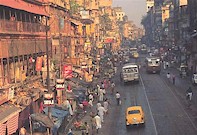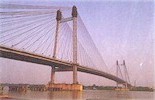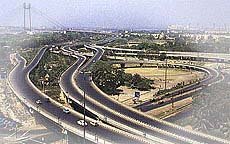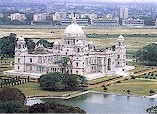 |
| Kolkata - A city with an enchanting past and fascinating present |
 |
| A breathtaking view of Kolkata (Calcutta) by night |
 |
| ‘Aath Chala’ |
‘Aath Chala’ is the courtyard with eight pillars and a roof top and with no walls. Under this ‘Aath Chala’ of the Savarna Choudhuri household, the three villages of Kolikata, Sutanuti and Govindapur were sold to East India Company at an amount of Rs.1,300/-. The legal document has the signatures of Roop Chand Mazumdar and Manohar Mazumdar and Charles Iyer, Job Charnock’s son-in-law. Antony Kobiyal’s grandfather was also present as one of the witnesses. In the deed of purchase in Persian language which was executed in 10th November, 1698 on the strength of which the East India Company acquired the zamindari rights over three villages, it was stated - “we conjointly have sold and made a true and legal conveyance of the village Dihi Kalkatah and Sutanati within the jurisdiction of paraganah Amirabad and village Gobindopur under the jurisdiction of paraganahs Paeqan and Kalktah, to English Company with rents and uncultivated lands and ponds and groves and rights over fishing and woodlands and dues from resident artisans,…… in exchange for the sum of one thousand and three hundred rupees……” Dihi Kalkatah, it is found, was clearly mentioned in the transfer deed by which Prince Azim-ush-Shan, Aurangzeb’s grandson granted the Company the zamindari rights over three villages. The family of Savarna Choudhuri had to relinquish the rights of the three villages under the pressure of the Prince on receiving a present of Rs.60,000/- from the Company.
 |
| Location |
It was on a rainy Sunday the 24th of August 1690 that Job Charnock of Lancashire, Chief of the British Factories of East India Company, on his third visit, anchored at Sutanuti on the eastern bank of River Hooghly and a settlement was started within four days of his arrival, which laid to the foundation of the great city of Calcutta. Job Charnock established a factory in Kalikata on 24 August 1690. This date is widely accepted as the foundation day of Kolkata (Calcutta). Kolkata (Calcutta) has come a long way since then. Its rise was meteoric - from a nondescript village to the Second City of the British Empire. Its decline has been equally rapid - from the City of Palaces to the city of poverty. This three hundred year old city is now at the cross roads of a new century. Will Kolkata (Calcutta) survive to see another three hundred years?
 |
| J L Nehru Road (Chowringhee Road) is an important thoroughfare |
 |
| M G Road is one of the many roads which are best avoided |
 |
| Electric Tram |
Kolkata (Calcutta) is one of the largest cities of the world and is the capital city of the state of West Bengal, in India. It is the former capital (1772-1912) of British India. The city boasts being the nation’s largest metropolitan in area. Kolkata (Calcutta) is located on the eastern bank of the Hooghly River, an arm of the Ganges, about 96 miles (154 km) upstream from its mouth at the head of the Bay of Bengal. This river port is the most important urban center of Eastern India. The core city is sandwiched between the river on the west, the salt lakes to the east and the marshes and the swamps to the south. The Calcutta Municipal Corporation spreads over an area of 187.33 sq km with a population of 4,388,262 (1991 census). The metropolitan area of about 800 sq kms extends along both sides of the river Hooghly from Bandel / Kalyani in the north to Budge Budge in the south and from Howrah in the west to Bidhan Nagar in the east. This urban agglomeration is home to a population of around 10 million and has three municipal corporations (Calcutta, Howrah, Chandannagore), 35 municipalities and several villages.
Construction of India’s first subway system was begun in Kolkata (Calcutta) in 1973; a section in the central area opened in 1986. National highways and railways connect Kolkata (Calcutta) to other cities; Sealdah and Howrah stations are the terminals of several railway lines; and air service is provided by the Netaji Subhas Chandra (Dum Dum) International Airport.
Western and Eastern influences mingle in Kolkata’s (Calcutta) architecture: Victoria Memorial, one of the city’s finest buildings, represents a mixture of classical Western and Mughal (Mogul) styles. Kolkata (Calcutta) is known as the ‘Cultural Capital’ of India. The city is the birthplace of modern Indian literary and artistic thought and of Indian nationalism, and the efforts of its citizens to preserve Indian culture and civilization have no parallel in the rest of the country. It serves as the major educational and cultural centre, catering to a cosmopolitan population speaking Bengali, English, Hindi, and Urdu. Higher education is offered by the universities of Kolkata (Calcutta), Jadavpur, and Rabindra Bharati. Established by the British, The Indian Museum is the oldest in India. A host of other museums also offer collections of archaeological and historical artifacts and folk and fine arts. Valuable literary collections are housed in the National Library which meet the varying tastes of different readers.
 |
| Downtown Kolkata (Calcutta) |
 |
| Vidyasagar Setu |
 |
| Flyover Networks |
 |
| Victoria Memorial Hall |
 |
| Science City |
Today Kolkata (Calcutta) is one of the world’s largest cities. Kolkata (Calcutta) as a city suffers from a severe image problem. Kolkata (Calcutta) is synonymous with urban poverty and squalor. It is a city associated with bandhs (strikes), michils (processions) and bampanthis (leftists). Add to these lockouts, closures, gheraos, abarodhs (blockades), sit-ins, hunger strikes, pollution, filth, traffic snarls, blackouts, water logging, an ever growing population, a limited infrastructure, a poor administrative setup and you have a perfect recipe for an urban chaos.
The problems of Kolkata (Calcutta) are many and cannot be wished away. The infrastructure of the metropolitan area is not adequate for the ten million people who call this region home. Unplanned development for the better part of the city’s three centuries of existence has taken its toll. Shortage of funds coupled with low incomes has not helped either. Housing shortage has resulted in the growth of slums. Roads are few while the traffic has increased by a tremendous amount. Public transportation is extremely crowded. Sanitation, water supply, pollution, health, access to education and the state of the economy are major areas of concern.
Despite all the negative points stacked against it, Kolkata (Calcutta) is representative of the human nature of surviving against all odds. The growing concern for the city is slowly bringing about the awareness about the fact that in this age of competition and hype, complacency is no longer a viable option. Over the past decade, Kolkata (Calcutta) has shown some slow, but marked improvements. From intelligent buildings to condovilles, from luxury hotels to software parks - Kolkata (Calcutta) is undergoing a transformation, along with the rest of the country. The city has the nation’s first underground railway system, The Metro Railway, which runs from DumDum to Tollygunge. Construction is undergoing for an extension from Tollygunge to Garia. The Science City is the largest of its kind in the country. The Vidyasagar Setu with it’s network of criss-crossing and overlapping flyovers is a marvel by it’s own right. The Vidyasagar Setu or the Second Hooghly Bridge spans over the Hooghly River linking Kolkata (Calcutta) to its twin city of Howrah and on to Mumbai, Chennai and Delhi. This is a toll bridge and gives a fast connection from downtown Kolkata (Calcutta) to the Botanical Gardens, which has the world’s biggest banyan tree, and the Bengal Engineering College, the second oldest technical college of India and a premier technical University today). The Government has initiated projects like slum redevelopment schemes, new housing complexes, flyovers, hospitals and industries. A planned new township is coming up at Rajarhat. However large scale private sector participation and investments are needed to make a major impact in the lives of its citizens.
 |
 |
 |
| Metro Rail | Town Hall Pride of Heritage |
Infinity Complex |
Beyond the facade of the concrete jungle lies a big hearted city - a city of culture, a city of sports lovers, a city of festivals and a city which doesn’t judge its citizens on the basis of wealth.
